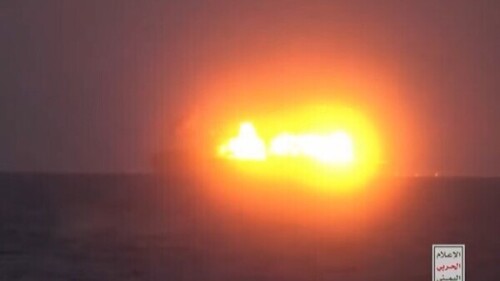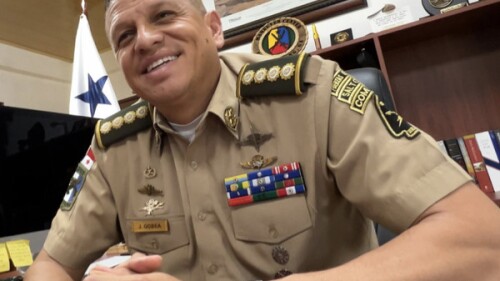Iran’s fake aircraft carrier under construction in 2014. |
On Aug. 2, Iran imposed fake sanctions on a former White House Security Council member. The week before that, the Iranian navy dramatically attacked a fake U.S. aircraft carrier in the Persian Gulf. In April, the leader of the Islamic Revolutionary Guard Corps (IRGC) unveiled a fake machine to detect the very real coronavirus. What’s going on with Iran — is everything there fake?
Richard Goldberg, a senior advisor at the Foundation for Defense of Democracies, is the American security expert who was “sanctioned” by Iran. His alleged offense? As part of the Trump administration, he participated in “U.S. economic terrorism against interests of the Islamic Republic and its citizens,” according to the IRNA news agency. Consequently, Goldberg no longer would be able to open accounts in Iranian banks or conduct transactions with Iranian nationals, and, of course, he would be denied a coveted Iranian passport. So what? Exactly.
The “sanction” was worse than merely symbolic. It was an ineffectual gesture made by an impotent government, teetering on the edge and hoping no one important notices. Goldberg handled it in good spirits, tweeting: “Today I gain a new badge of honor: ‘sanctioned’ by Iran for coordinating @realDonaldTrump’s maximum pressure campaign.”
On July 27, Iran towed a fake aircraft carrier from the port city of Bandar Abbas to the Strait of Hormuz. It was a mock-up of an American Nimitz-class carrier — the very real ones regularly patrol the Gulf — complete with fake U.S. Navy jets painted onto the deck. It was the same fake American craft the IRGC towed out in February 2015 to “destroy” in a show of fake bravado for a military exercise called “Great Prophet 9.” Both “attacks” involved IRGC speedboats valiantly firing their machine guns, rockets and missiles at the mock vessel.
Like Mr. Goldberg, the U.S. Navy’s 5th Fleet based in Bahrain, appeared to be amused at the display. When Cmdr. Rebecca Rebarich was asked about the carrier, she replied that the U.S. is “confident in our naval forces’ ability to defend themselves against any maritime threat.” When they were done with their war games, the IRGC towed the fake carrier back to Bandar Abbas, but it capsized and sank. It now poses a real threat to ships attempting to navigate the port.
Not much has been heard about the IRGC’s COVID-19 detector since its unveiling in April. |
Back on April 15, when COVID-19 deaths were mounting in Iran, the IRGC commander in chief, General Hossein Salami, went on IRINN TV to present “a wondrous and exclusive scientific and technological phenomenon that can detect coronavirus from as far as 100 meters away within five seconds.” The fake medical device looked like a squirt gun with a set of “rabbit ears” television antennae attached. Salami claimed that the device works by creating a magnetic field with a “bipolar virus” that detects the novel coronavirus (and any other virus, he added). He boasted that this medical wonder had an accuracy rate of 80 percent.
Even Iran’s government seems to be fake. When the Ayatollah Ruhollah Khomeini and his fellow jihadis established their Islamic government in 1979, they needed the help of young communists, atheists, democrats and nationalists, so he fooled them (and many others) by dressing the theocracy up to look like a democracy, complete with elections of hand-selected candidates so that there was virtually no chance of any dissenters getting elected. He even gave his theocracy an Islamic Constitution.
The Iranian Constitution is meaningless. It repeatedly affirms a variety of human rights only to negate them with vague phrases such as “except where prohibited by law” or “if it is not opposed to Islam.”
For example, Article 13 affirms freedom of religion “within the limits of the law.” Article 21 proclaims that “The government must assure the rights of women in all respects, in conformity with Islamic criteria.” Article 24 mentions a “free press ... except where detrimental to Islam.” Article 31 confirms a “right to a dwelling ... commensurate with one’s needs, from which one cannot be banished except as provided by law.”
What kind of “constitution” affirms a right unless another unspecified law or religious ruling, to be issued at a later date, renders it null and void? A useless one. No, worse, one evidently designed to fool people.
The promise of rights that don’t exist unless the government says they exist is an empty promise. All of the rights adumbrated in the Iranian constitution can disappear with the latest fatwa or the newest law, written and approved by the Supreme Leader’s hand-picked representatives.
Never in history has a “supreme leader” volunteered to become just a pretty powerful one, but that’s exactly what it would take for genuine reform in Iran. Supreme leaders either die as such or they involuntarily lose their status — usually along with their lives. Supreme Leader Ali Khamenei obviously has chosen to lie about the facts in Iran to divert attention from the mess that 40 years of his theocracy has wrought.
Khamenei has directed the Central Bank of Iran to issue fake statistics about the Iranian economy, ordered the IRGC to release fake satellite images, allegedly taken by its NOOR-1 satellite (which Gen. John Raymond of the U.S. Space Command called “a tumbling webcam in space”), and ordered the Iranian Health Ministry to lie about the number of people killed by COVID-19 in Iran.
Iran’s government lies about everything from its military prowess to its command of science.
So, what is real in Iran? Its small and shrinking economy, with fewer and fewer options, is real — Venezuelan grocery stores aside. The growing number of Iranians who appear to be increasingly fed up with the theocracy are real. And Iran’s incompetent government really has been lying about everything from its military prowess to its command of science.
Perhaps what the mullahs should worry most about is another reality — the mysterious fires and unexplained explosions occurring with alarming frequency throughout Iran’s military and nuclear facilities. They, too, are very real.
A.J. Caschetta is a Ginsberg-Milstein fellow at the Middle East Forum and a principal lecturer at the Rochester Institute of Technology.









